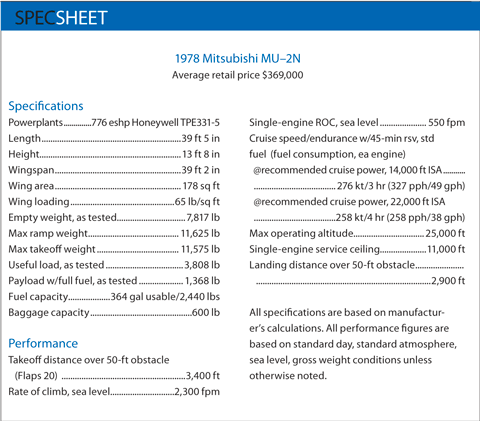Mitsubishi MU-2: Addictive performance
Best bang-for-the-buck turboprop
Related Articles
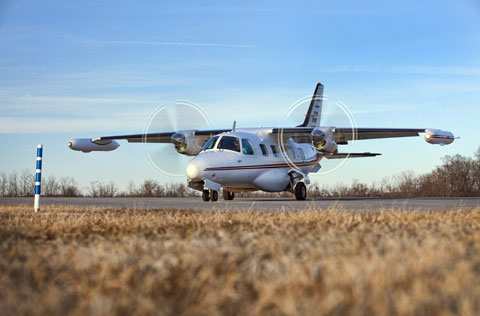
Mitsubishi’s entrant to the American general aviation scene in the late 1960s—the MU–2 twin turboprop—was a cutting-edge airplane that, performance-wise, blew the doors off the competition. At the time, the Beech King Air 90 couldn’t come close to the speedy Japanese newcomer. And the MU–2 was every bit as good a short/rough-field airplane as the King Air.
Today, the MU–2 is still a performance leader bested in cruise speed by only contemporary—and much more expensive—King Airs (300 and 350), and the rare Piper Cheyenne 400LS. But the MU–2 has been plagued with a reputation of being an unforgiving, or outright dangerous, airplane. A few high-profile accidents, including one that killed a prominent politician, didn’t help the MU–2’s reputation. But MU–2 owners and operators are its most ardent supporters. They argue that the MU–2’s formerly eyebrow-raising accident record had nothing to do with the design, but with improperly trained pilots. After the NTSB recommended—and the FAA followed through with—a Special Certification Review of the design in 1983, the MU–2 came out with a clean bill of health supporting the owners’ theory.
Mitsubishi repeatedly petitioned the FAA to consider requiring a type rating for the MU–2, despite the fact that its maximum takeoff weight is less than 12,500 pounds—the lower weight limit for airplanes that require a type rating. That rule wasn’t adopted but MU–2 pilots are subject to the equivalent of a type rating and mandatory annual training per SFAR 108. As a result, the MU–2’s accident rate has improved significantly.
Design highlights
Model lineage is confusing with progressive letter suffixes affixed to completely different models. It’s easiest to refer to MU–2s as either long body or short body. Model years 1979 through 1985 were given names—Solitaire (short body) and Marquise (long body).
Understanding the MU–2’s strengths means analyzing its novel design. The MU–2’s wing is the secret to its wide performance envelope. With flaps up, the wing area is 178 square feet—the same as a Piper J–3 Cub—allowing the smaller MU–2s to speed along at 310 knots or better. But that little wing is supporting more than 11,000 pounds in the long-body models. With its full-span, double-slotted, Fowler-action flaps down to 40 degrees, the wing area increases about 21 percent, allowing the MU–2 to fly approaches at speeds as low as 101 knots. While stall speeds of the long-body version are in the 80-knot range with flaps down, clean stall is 26 knots faster at 106 knots. As a result, the MU–2 has minimum speeds based on flap settings—much like large jets do.
The full-span flaps don’t leave room for ailerons on the trailing edge of the wing. For roll control, the MU–2 uses roll spoilers. Turn the yoke right and a spoiler on the top of the right wing goes up to reduce lift on that wing, causing a bank. You can keep your feet on the floor during turns since there are no ailerons to create adverse yaw.
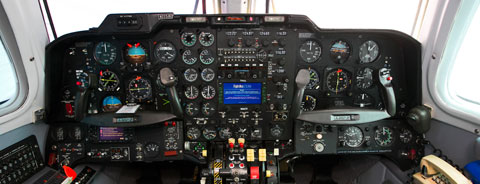
Flying the MU–2
Jim Burton’s MU–2, featured on these pages, is a 1978 N model, one of the roomy long-body models that lacks the higher-power Honeywell TPE331-10 engines available as an upgrade through an STC, and which became standard in later MU–2s. Burton uses his MU–2 in support of his database management business, flying it as far as Kansas and Florida from his Manassas, Virginia, base.
Having flown 20-series LearJets earlier in his career, Burton was well prepared to take ownership of an MU–2. And like most pilots who fly the MU–2, Burton is thoroughly impressed with the airplane. He is also well versed on its systems, limitations, and unique traits—the way it should be with anyone who flies an airplane of this caliber.
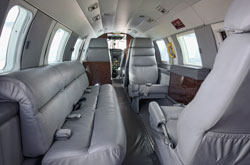 The MU–2 flies wonderfully but it needs to be flown like a jet—by the numbers. With Burton’s help, I found that you don’t need to touch the “aileron” trim (basically small servo tabs on the trailing edge of the flaps) at all during normal, two-engine flight. As long as the power is set evenly and the ball centered using rudder trim, the MU–2 is rock stable. And that high wing loading means the airplane rides through turbulence without much fuss, like a jet.
The MU–2 flies wonderfully but it needs to be flown like a jet—by the numbers. With Burton’s help, I found that you don’t need to touch the “aileron” trim (basically small servo tabs on the trailing edge of the flaps) at all during normal, two-engine flight. As long as the power is set evenly and the ball centered using rudder trim, the MU–2 is rock stable. And that high wing loading means the airplane rides through turbulence without much fuss, like a jet.
Takeoffs are exhilarating since the airplane sits so low to the ground. Acceleration is brisk. Short-body MU–2s have their main landing gear behind the CG, requiring quite a pull to rotate. Once the airplane breaks ground, you have to relax the back-pressure you used to haul it off the runway. The long-body airplane requires a tug but otherwise is essentially standard in its takeoff handling. With four people, full fuel, and cool temperatures, the MU–2 exceeded 2,000 feet per minute in the initial climb.
Burton sets cruise power by fuel flow rather than using the torque gauges—it’s more accurate in his airplane. If the fuel flows are matched, the ball stays in the center, reducing pilot workload and adding comfort. The MU–2 has a powerful rudder so it’s quite sensitive in yaw. You’ll need all of that rudder, though, if one of those 715-shaft-horsepower engines quits at low airspeed. Thankfully, the MU–2 has a negative torque sensing system that automatically increases propeller-blade pitch to significantly reduce drag in the event of a power loss. It needs to be checked prior to every flight.
Approaching a stall in the clean configuration met with some rumbling about 5 knots before the stick shaker activates. In the landing configuration (flaps 20, gear down) the stick shaker activated at 85 knots. To recover, we simply added power and flew out of it—very well behaved.
Burton typically cruises westbound in the high teens where he can get 280 KTAS on 76 gph at 96-percent rpm. Eastbound trips are made in the low 20s where fuel flow drops to about 68 gph on 270 KTAS at 96-percent rpm. The more powerful Solitaire and Marquise models hold their power to much higher altitudes and can break 300 knots. The short-body Solitaire tops out at 310 knots.
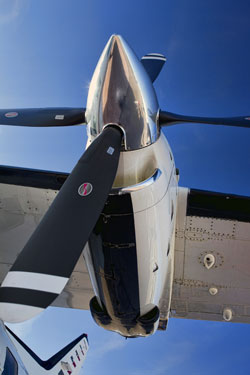 Did you forget about that crossing restriction in your descent clearance? Pull the power levers to idle, push the nose over, and you can hit 4,000 fpm with no problem. You can get still more descent rate by pushing the propeller levers to 100 percent and pegging the VSI at 5,000 fpm or more. The propeller disc area is huge and makes a very effective speed brake.
Did you forget about that crossing restriction in your descent clearance? Pull the power levers to idle, push the nose over, and you can hit 4,000 fpm with no problem. You can get still more descent rate by pushing the propeller levers to 100 percent and pegging the VSI at 5,000 fpm or more. The propeller disc area is huge and makes a very effective speed brake.
I found nothing unusual about the MU–2’s approach and landing aside from the perceived alarm of landing so close to the ground and, as a result, flaring too high. There is very little flare, as well. Mostly you just fly it until your butt is a few feet above the runway and arrest the rate of descent. Short-body MU–2s, with the main landing gear located far behind the CG, tend to drop their nose down immediately after the mains. Land with a little power to eliminate this tendency. The long-body model is much more civilized. Pull the power levers into ground idle (beta) and the props alone will stop the MU–2 quickly with no need for brakes. Reverse is also available, if needed. Taxiing also requires no brakes. Turning radius is wide, however.
MU–2 characteristics
The MU–2’s reputation isn’t helped by its “unique” characteristics. Prejudiced pilots may automatically dismiss the MU–2 just because it looks and handles differently compared to typical turboprops, most of which evolved from piston airplanes. But this purpose-built turboprop’s quirks are some of the qualities that make it endearing to its owners.
The engines are compact but make quite a racket, especially on the ground as they idle in the 76-percent range. The four-blade props turn counterclockwise (if viewed from behind the airplane)—opposite of most other airplanes. As a result, torque and P-factor require left rudder during climbout. The right engine becomes the so-called “critical” engine when it comes to engine-out handling.
Fuel is delivered from the 90-gallon (each) tip tanks inboard to the 154-gallon central main tank via bleed air pressure. There are also 15- or 35-gallon (depending on model) outer tanks that transfer fuel to the header tank via electric pumps. All told, Burton’s N model holds 364 gallons usable. He plans on 4.5 hours of fuel until the tanks are dry, which is good for about 1,400 nm. Later models have as much as 406 gallons usable.
With 600 pounds of fuel at each wing tip on an airframe with a narrow-track landing gear, the MU–2 leans quite a bit to the heavy side. The drill is to fill the main and outer tanks first, then put 45 gallons in one tip, go to the other tip and fill it, and finally return and top off the first tip. Many well-intentioned rampers have placed a stepladder underneath a tip tank, filled it up, and found themselves unable to remove the ladder—with resulting tank damage.

Engine-out handling
MU–2s fly quite well on one engine. However, the MU–2’s morphing wing requires some special attention to maintain control in a low-speed, engine-out condition. Pilots learning to fly typical multiengine piston airplanes are trained to assure that the gear and flaps are up to maximize performance. But with the MU–2, retracting flaps at low airspeed with an engine out can result in a complete loss of climb performance. Remember that 26-knot difference in stall speed between flaps up and down? Like a jet, the MU–2 has VYSE speeds for flaps set at the typical 20- and five-degree takeoff settings. MU–2 pilots are trained to leave the flaps alone after an engine failure until accelerating to at least the appropriate VYSE for the next flap setting.
More important than cleaning up after an engine failure is the need for the pilot to get the airplane under control and nail the correct rudder input. After that, the pilot need only adjust the aileron trim (the servo tabs on the flaps that work like ailerons) to trim away the spoiler input. A spoiler raised on the wing of the operating engine doesn’t help your climb rate. Testing verified that it reduces single-engine climb by about 50 fpm. Once cleaned up, a fully loaded MU–2 can expect to climb 500 fpm on one engine.
Support
 For an airplane that’s been out of production for 26 years, MU–2 owners are treated to fantastic factory support. Responders to Aviation International News’ survey of support have ranked Mitsubishi tops in its category for the past eight years. And Mitsubishi’s assistance doesn’t end in the maintenance shop. Mitsubishi, SimCom, and Honeywell host the free Pilot’s Review of Proficiency (PROP), a two-day safety seminar held in various locations around the country.
For an airplane that’s been out of production for 26 years, MU–2 owners are treated to fantastic factory support. Responders to Aviation International News’ survey of support have ranked Mitsubishi tops in its category for the past eight years. And Mitsubishi’s assistance doesn’t end in the maintenance shop. Mitsubishi, SimCom, and Honeywell host the free Pilot’s Review of Proficiency (PROP), a two-day safety seminar held in various locations around the country.
Intercontinental Jet in Tulsa, Oklahoma, is a Mitsubishi authorized service center and holder of the Dash-10 engine-conversion STC. Turbine Air Services provides support to MU–2 owners and operators and, in concert with the FAA and other MU–2 training facilities, was a player in establishing the common flight training manual and checklists that are required per SFAR 108.
Why MU–2?
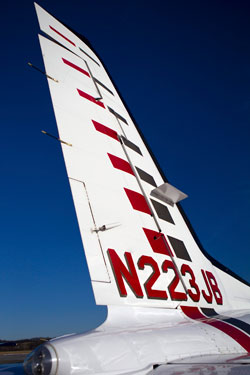 For operating economy, you can’t beat an MU–2. To cruise at 300 KTAS on 70 gph, use almost any airstrip, and enjoy a spacious cabin with room for up to 11, you’d think you have to spend more than $1 million. When you consider block-to-block times, the MU–2 is essentially as fast as a jet on trips of 400 nm or less.
For operating economy, you can’t beat an MU–2. To cruise at 300 KTAS on 70 gph, use almost any airstrip, and enjoy a spacious cabin with room for up to 11, you’d think you have to spend more than $1 million. When you consider block-to-block times, the MU–2 is essentially as fast as a jet on trips of 400 nm or less.
The MU–2 can compete with the efficiency of cabin-class piston twins. On an 800-mile trip, the MU–2 will arrive about an hour earlier and will have burned 200 gallons of Jet-A, compared to about 150 gallons of 100LL. Compare the Honeywell engines’ TBO of 5,400 hours to a maximum of 2,000 for a high-powered piston engine and things really begin to even out. Finally, the MU–2 is dimensionally about the same size as cabin-class piston twins, allowing it to fit in large T-hangars.
Insurance-wise, MU–2 owners will find reasonable premiums following completion of any of the programs that meet the mandatory training requirement of SFAR 108. Since hull values are low, premiums are often in line with any other airplane in this class—or lower. Over the 11 years Burton has owned his airplane, premiums have ranged from $10,000 to $26,000 a year.
The MU–2 won’t win any beauty contests, but its solid build and impressive performance allow its owners to find its inner beauty.
The controversy over the type is largely undeserved. After several official reviews of the design’s performance, handling, systems, and training, it has come out largely unscathed. It’s a unique airplane that rewards precise flying and awareness of its design characteristics. We can see how pilots stepping up from a forgiving light twin or complex single can get themselves in trouble with an MU–2, but with the training requirements and loyal support, any pilot respectful of the type should be comfortable in 50 hours or so.
Pete Bedell is a first officer for a major airline and co-owner of a Cessna 172 and Beechcraft Baron.
